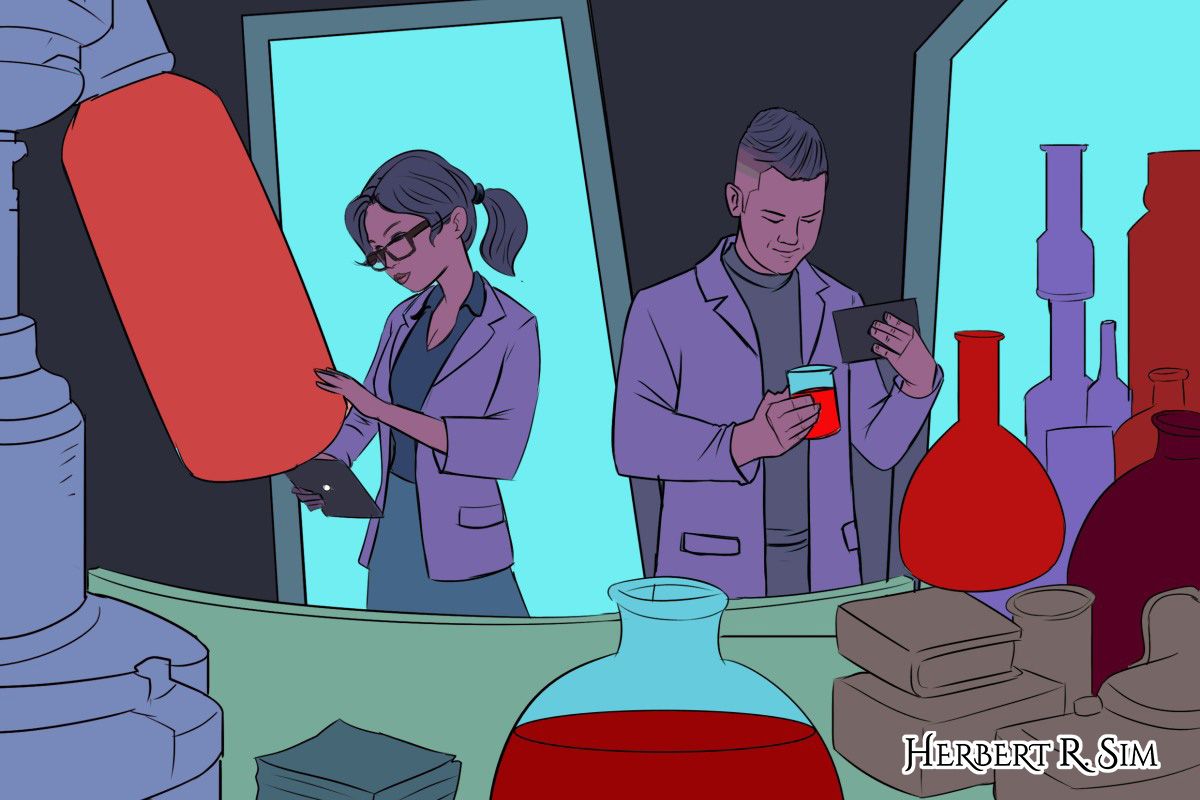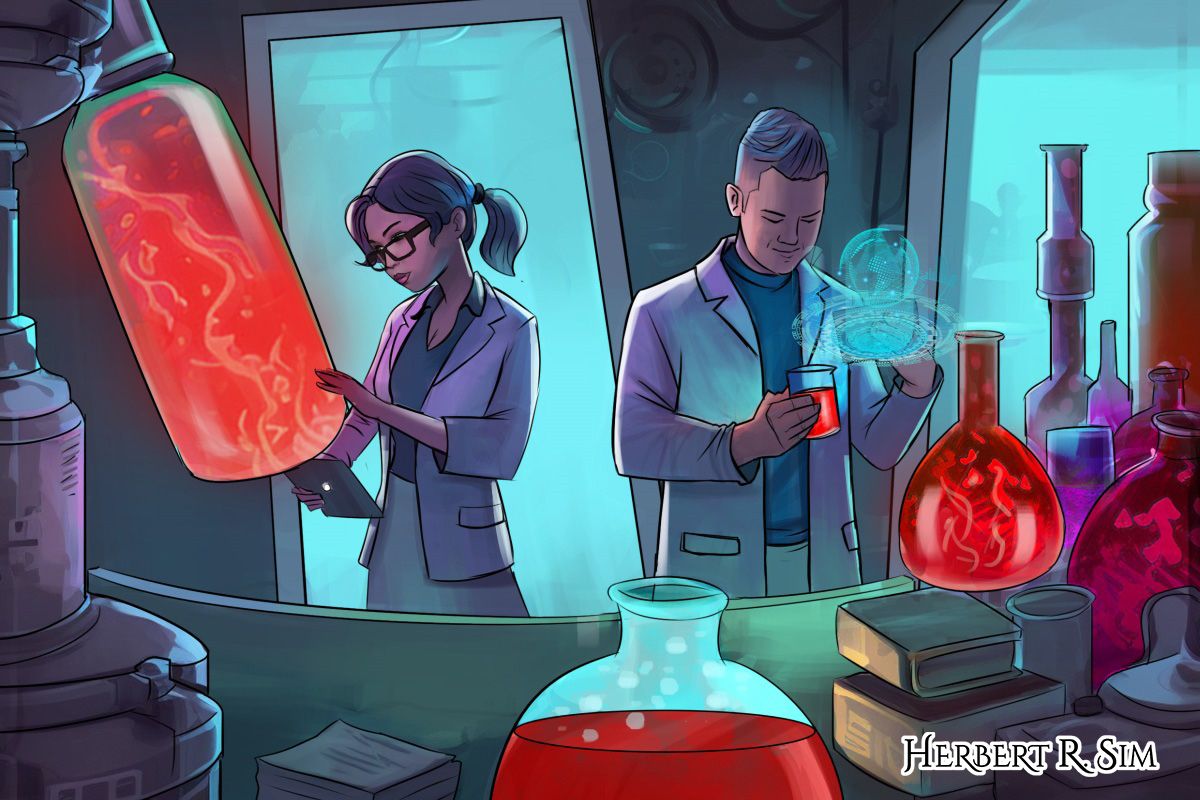
To depict the creation of synthetic blood, I illustrate two scientists in a laboratory mixing chemicals.
———————————————————
The blurring of lines between fact and fiction is often depicted on both small and big screens, propagated by a mix of popular culture and scientific reality.
TV hits like True Blood, while portraying a fictitious narrative, is able to embed and sprinkle scientific concepts – artificial blood for example – that is craved by a group of ridiculously attractive vampires. While still a work of fiction, recent scientific advancements have brought us closer to realising the dream of creating synthetic blood – a concept celebrated for its potential benefits – albeit with challenges that might halt scientists in their tracks, or delay progress that could turn synthetic blood into something tangible.
The call for artificial blood
Blood transfusions play an incredibly crucial role in modern medicine, helping to save countless lives each year across the world. However, the demand for blood often outpaces the supply, leading to a constant shortage which can be problematic for certain medical procedures and other urgent scenarios.
Artificial blood, also known as synthetic blood, is a viable solution that can be rendered as an alternative method to human blood donations. Additionally, synthetic blood is able to mitigate risks associated with blood transfusions, such as the transmission of infections and the possibility of adverse reactions due to blood type incompatibility.
When it comes to current developments, scientists are exploring multiple avenues in the development of synthetic blood, focusing primarily on two approaches: oxygen-carrying substitutes and stem cell-derived blood.
The primary function of blood is to transport oxygen from the lungs to the body’s tissues. To replicate this function, scientists have developed oxygen-carrying substitutes using molecules like perfluorocarbons (PFCs) and hemoglobin-based oxygen carriers (HBOCs). These molecules can efficiently bind to and release oxygen, mimicking the function of a red blood cell.
HBOCs use modified human or animal hemoglobin to transport oxygen, with its development driven by the need to overcome the limitations of PFCs. Scientists have made significant progress in reducing the side effects of HBOCs, such as hypertension and kidney damage, by attempting to chemically modify the hemoglobin molecule.
On the other hand, perfluorocarbons (PFCs) are synthetic molecules that can dissolve large amounts of oxygen. Biologically inert, they have been identified as oxygen carriers in artificial blood since the 1960s. However, their limited oxygen-carrying capacity and the need for high oxygen pressure in the lungs have posed challenges to their development.
Another promising approach to synthetic blood involves using stem cells to generate red blood cells in the lab. Scientists have successfully converted human embryonic stem cells (hESCs) into red blood cells, an excellent approach with a great potential for creating a virtually unlimited supply of blood.
———————————————————

Here is the work-in-progress, the sketching in GIF.
———————————————————
For the good of mankind
The development of artificial blood could revolutionise the field of transfusion medicine, offering several key benefits such as addressing blood shortages and reducing infection risks.
As highlighted earlier, synthetic blood could help overcome the persistent blood supply shortages faced by hospitals and blood banks, ensuring that patients in need of transfusions have access to life-saving treatment. For instance, the U.S. Department of Defense has been investing in research on artificial blood products to alleviate the issue of blood shortages in military settings.
The U.S. Army, in particular, has been actively pursuing the development of synthetic blood products, such as freeze-dried plasma and oxygen-carrying substitutes, to support combat casualty care. Additionally, artificial blood would not carry the risk of transmitting infectious diseases such as HIV, hepatitis, or other blood-borne pathogens, significantly improving the safety of blood transfusions.
Significantly, if scientists can also leverage synthetic blood to develop a “universal” blood type, this will help eliminate the need for blood type matching and perhaps even simplify the transfusion process. A study by the University of California, San Francisco (UCSF) demonstrated the feasibility of converting blood types A, B, and AB into type O, the universal donor type, which could pave the way for the development of a universal synthetic blood type.
Other benefits include a longer shelf life, where, unlike donated blood which has a limited shelf life, synthetic blood can potentially be stored for longer periods, making it a valuable resource for emergency situations and remote areas with limited access to blood supplies.
Charting progress and tackling hurdles
Despite significant progress being made in artificial blood development, several challenges remain. While the obvious difficulty of creating said synthetic product remains, a key challenge is in ensuring that the oxygen-carrying capacity of the artificial product is comparable to that of natural blood. Both PFCs and HBOCs have shown limitations in this regard, necessitating further research and development. For instance, researchers have been exploring the use of recombinant hemoglobin, encapsulated hemoglobin, and cross-linked hemoglobin to overcome these limitations and improve oxygen-carrying capacity.
There’s also the prominent consideration that all scientific and medical endeavors require: The issue of side effects and safety concerns. Essentially, the safety of synthetic blood products is paramount. Researchers must address potential side effects and adverse reactions associated with synthetic blood, whereby some HBOCs may pose the risk of hypertension and kidney damage.
In response to these concerns, scientists have been working on developing improved HBOC formulations and using nanotechnology to create safer alternatives, such as haemoglobin-encapsulated liposomes. Additionally, synthetic blood products must undergo rigorous testing and obtain regulatory approval before they can be used in clinical settings. The process of gaining approval can be lengthy and complex, potentially delaying the widespread use of artificial blood.
A working product may not necessarily translate to be a successful one, especially if production is unable to keep up with demand. When it comes to the development of artificial blood, particularly stem cell-derived blood, entering large-scale production could become a problem. Researchers must develop efficient and cost-effective methods for producing artificial blood in quantities sufficient to meet global demand. Recent innovations, such as the use of bioreactors for large-scale red blood cell production and the application of gene-editing technologies to enhance the efficiency of stem cell differentiation, are promising steps towards addressing this challenge.
The development of synthetic blood is an exciting and promising field of research, one that has the potential to transform the field of transfusion medicine. While significant challenges remain, the progress made thus far offers hope for a future in which blood shortages are a thing of the past, and the risks associated with blood transfusions are significantly reduced. As science continues to advance and bridge the gap between fiction and reality, the dream of synthetic blood may not dissipate into thin air after all.
———————————————————

In the final art illustration, you can see the shading and detailing in of the chemicals, and with a final touch of futurism – the male scientist with futuristic hologram screen.
https://pafipemkosubulussalam.org/
https://pafipemkoprabumulih.org/
https://pafipemkogunungsitoli.org/
https://pafipemkopadangsidimpuan.org/
https://pafipemkopematangsiantar.org/
https://pafipemkotidorekepulauan.org/
https://pafipulaupini.org/
https://pafipulausamosir.org/
https://pafipulaupadang.org/
https://pafipulausalahnama.org/
